SINGAPORE: As a university student, resources are “very limited” for Daniel Chan, who wears basics such as T-shirts “all the time”.
But if he can get a better deal when shopping, then it means he can “buy more things”. That is why he buys dupes, short for duplicates. These are cheaper alternatives to popular items.
“We (Gen Zers) love it when we score a good deal,” said the 24-year-old, wearing a S$10 T-shirt that was a dupe of a S$19.90 T-shirt from another brand.
Although the term “dupe” is used, it is not a replica of the original item. People who are into dupes know they are not buying the real deal but want it anyway.
WATCH: Why Gen Z loves dupes — Can cheaper also be better? (22:18)
“Young people are more conscious (of) what we (spend) our money on, so dupes have started to become a very big thing,” said Chan, who is also a TikTok influencer who recommends dupe products to his 81,000 followers.
With so many categories of dupes coming on the scene, the programme Talking Point reached out to viewers through an online survey and an Instagram poll to find out what they normally buy.
Among the 200-plus people who responded, clothes ranked top of the list. Accessories including bags ranked second, followed by make-up and perfume, electronics and other items such as household products.
Clothing dupes are so popular they are changing the way clothes are produced today, accelerating the production time and begetting what is called ultra-fast fashion.

Munah trying to figure out whether the belts look the same.
“With social media, luxury trends are a lot more visible and accessible online to the mass consumer,” said fashion researcher Angelene Wong. “All this data then goes into the manufacturing process of ultra-fast fashion.
“Because of social media, (dupes) have been deemed to be of good quality but with a lower price point, and so these items have been de-stigmatised. … And because they’ve become so accessible, that lends (itself) to an increased consumption rate.”
Some dupes of beauty products are almost three times cheaper. Some activewear dupes are 90 per cent cheaper than the originals. One of the Talking Point viewers who usually buys dupe watches reckoned he has saved S$8,000 to S$9,000.
Besides the lower price tag making for better value, a good dupe for Chan is one that serves the same function as the original and is still good quality. “It gives you perhaps the same vibe,” he said.

TikTok influencer Daniel Chan showing Munah two blusher brands.
But does the I-want-it-now consumer mentality mean dupes are generally of poorer quality? How good a bargain are dupes, really?
To get some answers, Talking Point puts some products to the test. It also delves into dupe culture in a two-part special and goes to China — where many dupes originate — for an inside look at the industry.
In China, if an item is popular, there will almost definitely be a cheaper alternative, from sports shoes to Bluetooth headsets. But by far the most popular dupe category is clothing, Talking Point found.
Take, for example, activewear, which Qingdao M&Y Trading produces. Its best-selling items are its range of leggings, which are dupes of “big brands”, said owner Li Xue Mei.
There are, of course, differences between its dupes and the originals. “We made the pockets larger. And for some big brands, the waistband is shorter, but … we (Chinese) prefer it higher to give you a more defined waist,” she said.
“We also have over 30 colours for each of our styles. The colours are all very bright. We also made improvements to the fit based on the weight and size of Asians.”
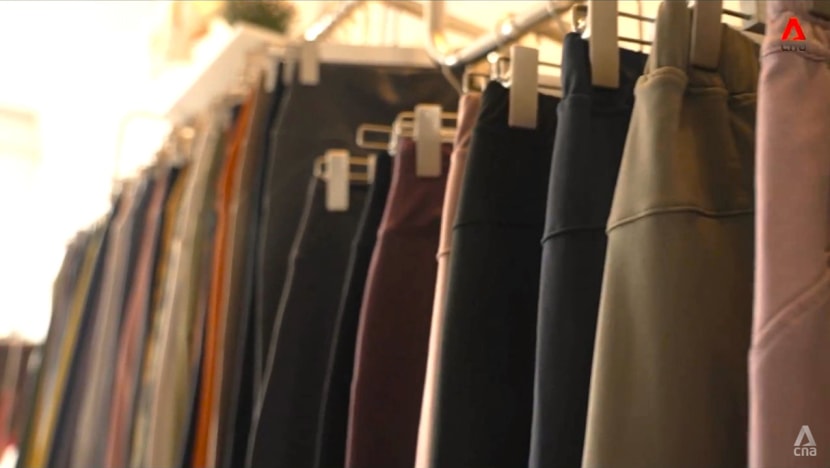
Leggings in the Chinese company’s showroom.
While the original leggings retail at nearly S$160 in Singapore, her company sells its dupes at 10 per cent of that price.
“It’s all about production volume,” she said. Of the two million pieces of activewear the company sells a year, leggings account for about 1.3 million pieces.
It is on e-commerce platforms such as Taobao and Alibaba. Besides selling domestically, it has sales in countries such as Australia, Russia, Singapore and Vietnam.
“We don’t have any publicity costs,” Li added. Instead, the company promotes its products on social media, for example, by making use of live-streaming.
Live streams are profitable not only for companies like hers but also live streamers like Lai Qing, who sells dupe clothing on his channel. He frequents a 250,000-square-feet wholesale complex in Hangzhou to check out trending dupes in shops there.
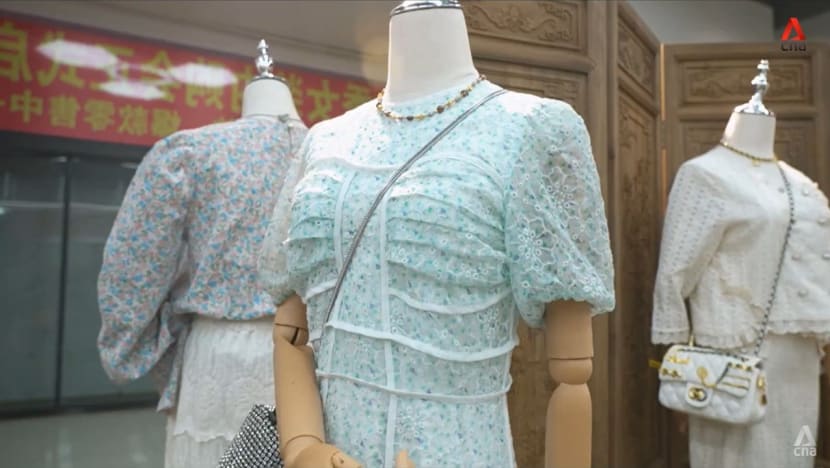
Inside the wholesale complex in Hangzhou.
Then he sources items directly from the factories producing them. “For live streams, we’ll multiply the cost price … by 1.8 to get the retail price,” he said. “You can also hit a selling price of three times the cost price.”
“Each live stream, we hope to sell 1,000 to 3,000 pieces of clothing. Fans who want to buy dupes in China are in the millions, I think. But because of the increasing number of live streamers, the market’s getting saturated.”
It has become big business. The wholesale complex in Hangzhou has 2,000 to 3,000 live-stream rooms, he estimated.
Talking Point gained access to a couple of factories producing an array of dupes. At one household goods factory, the general manager shared how it operates in the dupe ecosystem.
“The client gives me a picture. We can create a sample in two to three days,” said Shu Kai of Yifan Daily Necessities. “After the client confirms the product, our production cycle can create 200 units in seven days.”
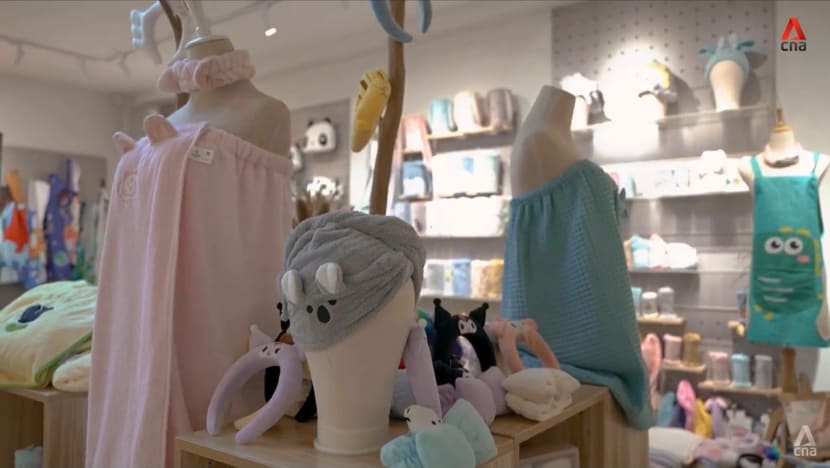
Inside the household goods factory.
Established suppliers of raw material and teams that run like clockwork mean cost savings all round. The company supplies a hair-drying towel, for example, that costs four times less than the branded original.
At one jewellery factory, the designs are “slightly similar to big-name designers”, said Dongyang Handu Accessories owner Li Mi Mi. Her dupes “sell very well”, she added, because people are familiar with the styles.
But she stressed that her company does not make direct copies of products and will reject such orders.
Dupes do occupy a grey area, especially when the products are almost replicas of the originals. Uniqlo, for example, is suing Shein for copying its popular shoulder bag that looks deceptively small despite its large capacity. The case is pending.
As dupes are widely available, it is hard to quantify losses suffered by the original brands. But companies are adjusting their business strategy.


Hair-care brand Olaplex created its own dupe, called Oladupe. It was a marketing campaign to say the original is irreplaceable.
Activewear brand Lululemon, meanwhile, held an event last year for customers in the United States to swop their dupe tights for the original.
Then there are businesses riding the wave of dupes. Josh Frost, for instance, started a business in 2022 that recreates well-known perfumes but makes them stronger than the originals.
“Some mainstream brands … use more filler, but that’s not necessarily a bad thing,” said Frost, who owns Best Perfume Store. “If you’d like that fresher, lighter smell — at about four per cent concentration — then mainstream brands are suited for you.
“If you’d like your perfume to last, maybe for eight hours out in the … sun, then ours would be better suited for you.”
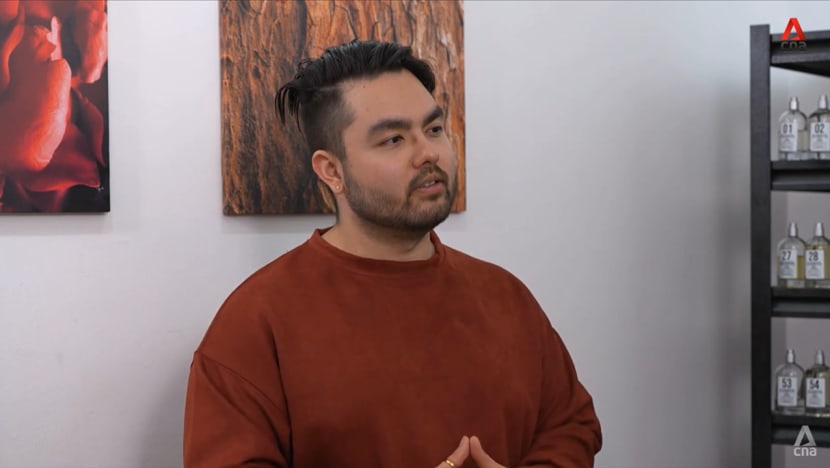
Best Perfume Store owner Josh Frost can take three weeks to recreate a scent.
So that he does not get tangled up in legal issues, he is mindful of brands’ names, bottle designs, shapes and colours. “Stay away from that, don’t deceive the consumer, and then you’re okay,” he said.
On whether the business of dupes is gaining acceptance, he said people are “definitely more focused on quality and affordability in our tough times”.
Having sold about 52,000 bottles in total, his business is “looking to expand into three retail stores” by year end.
Another who is “quite optimistic” about the prospects of the dupe market is Wang Yang. She heads a business strategy tour in China that links aspiring entrepreneurs looking for “good-quality products” with the factories manufacturing dupes and other products.
There is a growing consumption trend towards “the concept of dupes”, she said. “If you look at my house today, you’ll also find … that I’ve started to use dupes.”
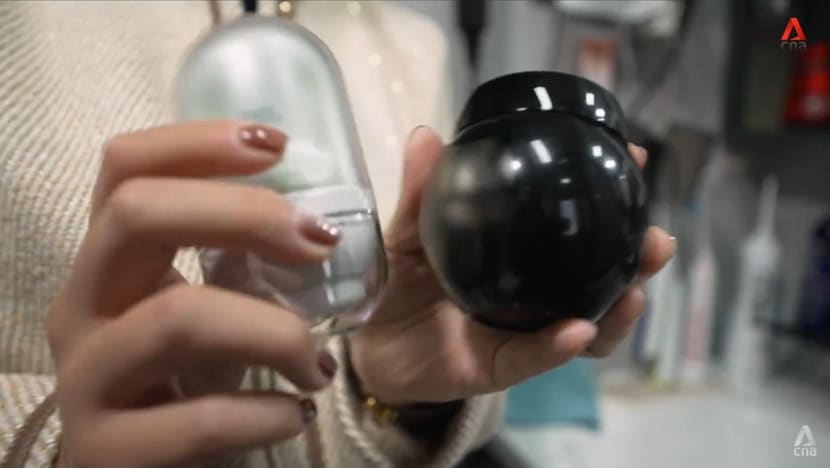
Two of the beauty products Wang Yang uses. The dupe is on the left.
But she does not think dupe companies will thrive “alongside” brand-name companies. The latter necessarily have “a lot of marketing elements” to create their brands, she said, whereas a dupe company “won’t really have its own brand identity or voice”.
There also remains a consumer focus on quality, she added. “If the price has come down, and the quality has come down, then that means I just bought a defective product.”
Can consumers tell the difference, however, between dupes and the originals?
Talking Point host Munah Bagharib conducted a little experiment with make-up to find out. On one side of her face, she wore her regular products, which cost almost S$520, and on the other side the best-matching dupes, costing about S$200.
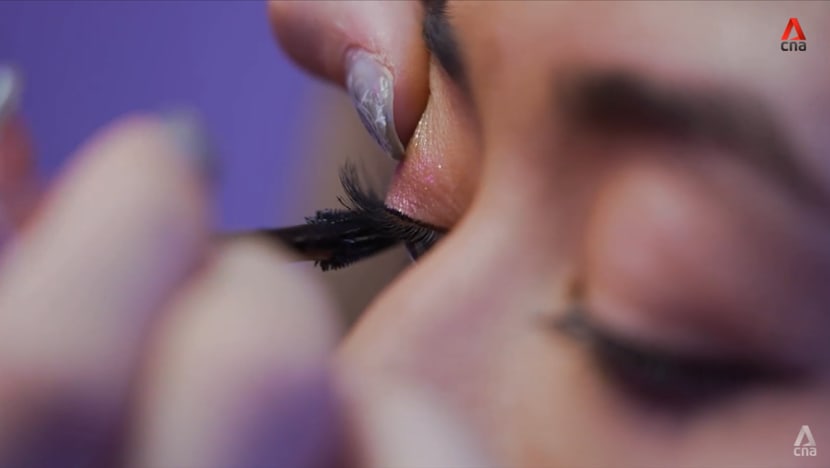
The make-up applied included dupe mascara.
Five viewers were roped in to form a panel of judges, and three of them guessed wrongly. After leaving the make-up on for eight hours, Munah herself was “surprised” to see no difference between the two powder foundations.
“I’d consider switching to the dupe. I’d also consider switching the brow pencils and the lipsticks because I can achieve the same look with the same quality at a much lower price,” she said.
“But I’ll stick to the original … blusher and eye shadow, as I can see and feel the difference in quality. My original blusher lasted longer without fading. And the original eye shadow, which has finer glitter flakes, blended better.”
When it comes to another category of dupes — electronics — viewers whom Talking Point spoke to were pickier about what they bought. Those who loved their dupes did choose items with some form of brand recognition and product warranty.
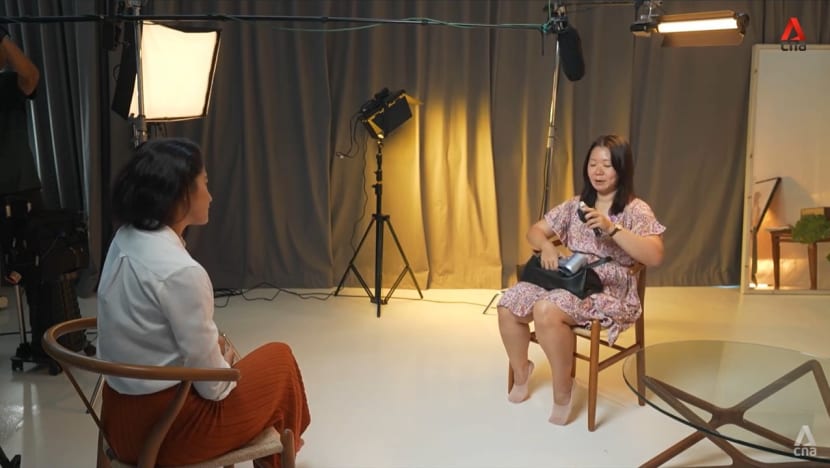
A Talking Point viewer showing Munah her dupe hairdryer and a wireless camera.
Their recommended dupe options include headphones and a hairdryer, with cost savings that can work out to more than S$800. But would these dupes perform like the originals?
One person who monitors and reviews products including dupe electronics is Delfina Utomo, an editor at lifestyle magazine 8 Days. And she helped Munah test a pair of dupe headphones she recognised as a popular purchase on Amazon and Shopee.
Compared to the original, she could hear a bit of music when Munah was wearing the headphones and the volume was increased. “If I’m sitting next to you on the train, I’d know your whole listening playlist,” she quipped.
To see if the dupe blocked external sound, Utomo played some background noise — which Munah could hear when there was a dip in the music she was listening to, unlike the original headphones.
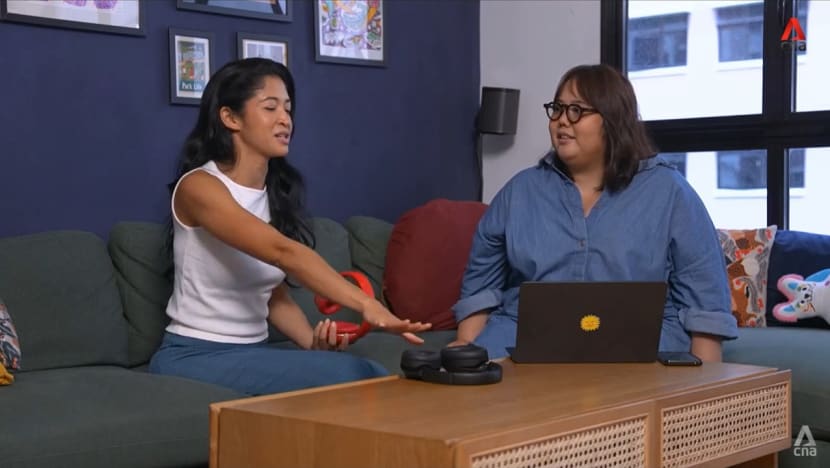
Munah, holding the dupe headphones, with 8 Days editor Delfina Utomo.
“The other thing I look at is Bluetooth connectivity — whether it stays connected when I walk around the house. Singapore’s houses are small, … but for some (dupes), it gets crackly,” said Utomo.
In this case, both headphones were consistent, which led her to conclude that the dupe was a “decent” set. Consumers can get it for around S$60, compared with S$360 for the original.
As for the hairdryer, Munah had it tested by hairstylist Zig Shee. He dried and styled her hair with the dupe first, then the original, both on the same settings: High heat to dry and style, cool air to set.
The results showed a “stark difference”, and the original “won by a fair bit” even though the dupe dried her hair faster by about five minutes.
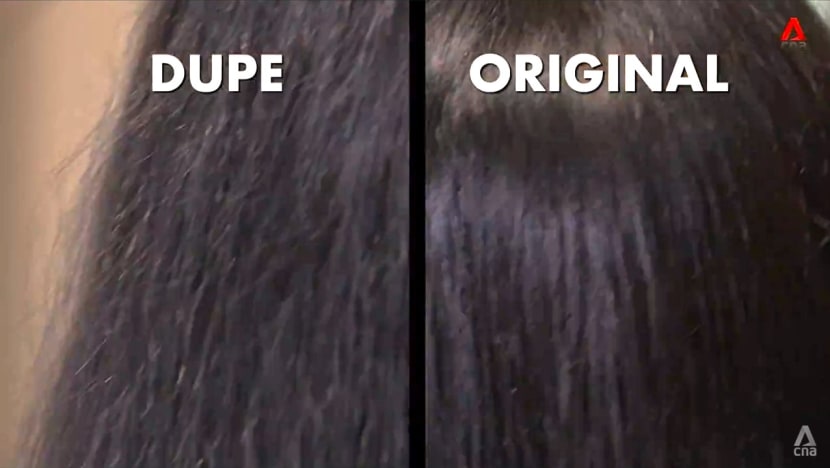
The results of the hairdryer test.
“The dupe gave a lot more frizz, whereas (with) the original, the hair was shinier and significantly smoother. … When I was using the dupe, I found it harder to manage in the sense that the heat was inconsistent,” said Shee.
“This did not match up to a fair bit of hairdryers that I’ve tried, as compared to the original and other bigger brands.”
Munah did her own value-for-money stress test on another set of dupes: an activewear outfit (a top and tights) brought back from China, which cost S$25.
Evaluating them on comfort, function and durability, she felt the tights were “just sticking to (her) skin” as she was working out and “sweating more and more”.
WATCH: When are dupes worth your money? (23:03)
On the fourth day of the week-long test, which included daily washes, she noticed that a bit of thread had come loose. By comparison, she has a S$266 branded outfit that looks as good as new after two years.
On the seventh day, she concluded: “These leggings aren’t as breathable as the originals. Function-wise, they do tend to bunch up when I’m doing high-intensity workouts. Wearing them during low-intensity workouts were fine, though.
“I don’t mind trying dupes to expand my wardrobe, just maybe not these.”
Watch the first episode of this Talking Point special here and the second part here. The programme airs on Channel 5 every Thursday at 9.30pm.

Continue reading...
But if he can get a better deal when shopping, then it means he can “buy more things”. That is why he buys dupes, short for duplicates. These are cheaper alternatives to popular items.
“We (Gen Zers) love it when we score a good deal,” said the 24-year-old, wearing a S$10 T-shirt that was a dupe of a S$19.90 T-shirt from another brand.
Although the term “dupe” is used, it is not a replica of the original item. People who are into dupes know they are not buying the real deal but want it anyway.
WATCH: Why Gen Z loves dupes — Can cheaper also be better? (22:18)
“Young people are more conscious (of) what we (spend) our money on, so dupes have started to become a very big thing,” said Chan, who is also a TikTok influencer who recommends dupe products to his 81,000 followers.
With so many categories of dupes coming on the scene, the programme Talking Point reached out to viewers through an online survey and an Instagram poll to find out what they normally buy.
Among the 200-plus people who responded, clothes ranked top of the list. Accessories including bags ranked second, followed by make-up and perfume, electronics and other items such as household products.
Clothing dupes are so popular they are changing the way clothes are produced today, accelerating the production time and begetting what is called ultra-fast fashion.

Munah trying to figure out whether the belts look the same.
“With social media, luxury trends are a lot more visible and accessible online to the mass consumer,” said fashion researcher Angelene Wong. “All this data then goes into the manufacturing process of ultra-fast fashion.
“Because of social media, (dupes) have been deemed to be of good quality but with a lower price point, and so these items have been de-stigmatised. … And because they’ve become so accessible, that lends (itself) to an increased consumption rate.”
Some dupes of beauty products are almost three times cheaper. Some activewear dupes are 90 per cent cheaper than the originals. One of the Talking Point viewers who usually buys dupe watches reckoned he has saved S$8,000 to S$9,000.
Besides the lower price tag making for better value, a good dupe for Chan is one that serves the same function as the original and is still good quality. “It gives you perhaps the same vibe,” he said.

TikTok influencer Daniel Chan showing Munah two blusher brands.
But does the I-want-it-now consumer mentality mean dupes are generally of poorer quality? How good a bargain are dupes, really?
To get some answers, Talking Point puts some products to the test. It also delves into dupe culture in a two-part special and goes to China — where many dupes originate — for an inside look at the industry.
BIG BUSINESS IN CHINA
In China, if an item is popular, there will almost definitely be a cheaper alternative, from sports shoes to Bluetooth headsets. But by far the most popular dupe category is clothing, Talking Point found.
Take, for example, activewear, which Qingdao M&Y Trading produces. Its best-selling items are its range of leggings, which are dupes of “big brands”, said owner Li Xue Mei.
There are, of course, differences between its dupes and the originals. “We made the pockets larger. And for some big brands, the waistband is shorter, but … we (Chinese) prefer it higher to give you a more defined waist,” she said.
“We also have over 30 colours for each of our styles. The colours are all very bright. We also made improvements to the fit based on the weight and size of Asians.”

Leggings in the Chinese company’s showroom.
While the original leggings retail at nearly S$160 in Singapore, her company sells its dupes at 10 per cent of that price.
“It’s all about production volume,” she said. Of the two million pieces of activewear the company sells a year, leggings account for about 1.3 million pieces.
It is on e-commerce platforms such as Taobao and Alibaba. Besides selling domestically, it has sales in countries such as Australia, Russia, Singapore and Vietnam.
“We don’t have any publicity costs,” Li added. Instead, the company promotes its products on social media, for example, by making use of live-streaming.
Live streams are profitable not only for companies like hers but also live streamers like Lai Qing, who sells dupe clothing on his channel. He frequents a 250,000-square-feet wholesale complex in Hangzhou to check out trending dupes in shops there.

Inside the wholesale complex in Hangzhou.
Then he sources items directly from the factories producing them. “For live streams, we’ll multiply the cost price … by 1.8 to get the retail price,” he said. “You can also hit a selling price of three times the cost price.”
“Each live stream, we hope to sell 1,000 to 3,000 pieces of clothing. Fans who want to buy dupes in China are in the millions, I think. But because of the increasing number of live streamers, the market’s getting saturated.”
It has become big business. The wholesale complex in Hangzhou has 2,000 to 3,000 live-stream rooms, he estimated.
There’s live-streaming, warehouse deliveries, logistics — the works. Once a live stream ends, (products) will be shipped out the next day.”
Talking Point gained access to a couple of factories producing an array of dupes. At one household goods factory, the general manager shared how it operates in the dupe ecosystem.
“The client gives me a picture. We can create a sample in two to three days,” said Shu Kai of Yifan Daily Necessities. “After the client confirms the product, our production cycle can create 200 units in seven days.”

Inside the household goods factory.
Established suppliers of raw material and teams that run like clockwork mean cost savings all round. The company supplies a hair-drying towel, for example, that costs four times less than the branded original.
At one jewellery factory, the designs are “slightly similar to big-name designers”, said Dongyang Handu Accessories owner Li Mi Mi. Her dupes “sell very well”, she added, because people are familiar with the styles.
But she stressed that her company does not make direct copies of products and will reject such orders.
A LEGAL MINEFIELD TO NAVIGATE
Dupes do occupy a grey area, especially when the products are almost replicas of the originals. Uniqlo, for example, is suing Shein for copying its popular shoulder bag that looks deceptively small despite its large capacity. The case is pending.
As dupes are widely available, it is hard to quantify losses suffered by the original brands. But companies are adjusting their business strategy.
Related articles:


Hair-care brand Olaplex created its own dupe, called Oladupe. It was a marketing campaign to say the original is irreplaceable.
Activewear brand Lululemon, meanwhile, held an event last year for customers in the United States to swop their dupe tights for the original.
Then there are businesses riding the wave of dupes. Josh Frost, for instance, started a business in 2022 that recreates well-known perfumes but makes them stronger than the originals.
“Some mainstream brands … use more filler, but that’s not necessarily a bad thing,” said Frost, who owns Best Perfume Store. “If you’d like that fresher, lighter smell — at about four per cent concentration — then mainstream brands are suited for you.
“If you’d like your perfume to last, maybe for eight hours out in the … sun, then ours would be better suited for you.”

Best Perfume Store owner Josh Frost can take three weeks to recreate a scent.
So that he does not get tangled up in legal issues, he is mindful of brands’ names, bottle designs, shapes and colours. “Stay away from that, don’t deceive the consumer, and then you’re okay,” he said.
On whether the business of dupes is gaining acceptance, he said people are “definitely more focused on quality and affordability in our tough times”.
Having sold about 52,000 bottles in total, his business is “looking to expand into three retail stores” by year end.
Another who is “quite optimistic” about the prospects of the dupe market is Wang Yang. She heads a business strategy tour in China that links aspiring entrepreneurs looking for “good-quality products” with the factories manufacturing dupes and other products.
There is a growing consumption trend towards “the concept of dupes”, she said. “If you look at my house today, you’ll also find … that I’ve started to use dupes.”

Two of the beauty products Wang Yang uses. The dupe is on the left.
But she does not think dupe companies will thrive “alongside” brand-name companies. The latter necessarily have “a lot of marketing elements” to create their brands, she said, whereas a dupe company “won’t really have its own brand identity or voice”.
There also remains a consumer focus on quality, she added. “If the price has come down, and the quality has come down, then that means I just bought a defective product.”
DUPES VERSUS ORGINALS
Can consumers tell the difference, however, between dupes and the originals?
Talking Point host Munah Bagharib conducted a little experiment with make-up to find out. On one side of her face, she wore her regular products, which cost almost S$520, and on the other side the best-matching dupes, costing about S$200.

The make-up applied included dupe mascara.
Five viewers were roped in to form a panel of judges, and three of them guessed wrongly. After leaving the make-up on for eight hours, Munah herself was “surprised” to see no difference between the two powder foundations.
“I’d consider switching to the dupe. I’d also consider switching the brow pencils and the lipsticks because I can achieve the same look with the same quality at a much lower price,” she said.
“But I’ll stick to the original … blusher and eye shadow, as I can see and feel the difference in quality. My original blusher lasted longer without fading. And the original eye shadow, which has finer glitter flakes, blended better.”
When it comes to another category of dupes — electronics — viewers whom Talking Point spoke to were pickier about what they bought. Those who loved their dupes did choose items with some form of brand recognition and product warranty.

A Talking Point viewer showing Munah her dupe hairdryer and a wireless camera.
Their recommended dupe options include headphones and a hairdryer, with cost savings that can work out to more than S$800. But would these dupes perform like the originals?
One person who monitors and reviews products including dupe electronics is Delfina Utomo, an editor at lifestyle magazine 8 Days. And she helped Munah test a pair of dupe headphones she recognised as a popular purchase on Amazon and Shopee.
Compared to the original, she could hear a bit of music when Munah was wearing the headphones and the volume was increased. “If I’m sitting next to you on the train, I’d know your whole listening playlist,” she quipped.
To see if the dupe blocked external sound, Utomo played some background noise — which Munah could hear when there was a dip in the music she was listening to, unlike the original headphones.

Munah, holding the dupe headphones, with 8 Days editor Delfina Utomo.
“The other thing I look at is Bluetooth connectivity — whether it stays connected when I walk around the house. Singapore’s houses are small, … but for some (dupes), it gets crackly,” said Utomo.
In this case, both headphones were consistent, which led her to conclude that the dupe was a “decent” set. Consumers can get it for around S$60, compared with S$360 for the original.
As for the hairdryer, Munah had it tested by hairstylist Zig Shee. He dried and styled her hair with the dupe first, then the original, both on the same settings: High heat to dry and style, cool air to set.
The results showed a “stark difference”, and the original “won by a fair bit” even though the dupe dried her hair faster by about five minutes.

The results of the hairdryer test.
“The dupe gave a lot more frizz, whereas (with) the original, the hair was shinier and significantly smoother. … When I was using the dupe, I found it harder to manage in the sense that the heat was inconsistent,” said Shee.
“This did not match up to a fair bit of hairdryers that I’ve tried, as compared to the original and other bigger brands.”
Munah did her own value-for-money stress test on another set of dupes: an activewear outfit (a top and tights) brought back from China, which cost S$25.
Evaluating them on comfort, function and durability, she felt the tights were “just sticking to (her) skin” as she was working out and “sweating more and more”.
WATCH: When are dupes worth your money? (23:03)
On the fourth day of the week-long test, which included daily washes, she noticed that a bit of thread had come loose. By comparison, she has a S$266 branded outfit that looks as good as new after two years.
On the seventh day, she concluded: “These leggings aren’t as breathable as the originals. Function-wise, they do tend to bunch up when I’m doing high-intensity workouts. Wearing them during low-intensity workouts were fine, though.
“I don’t mind trying dupes to expand my wardrobe, just maybe not these.”
Watch the first episode of this Talking Point special here and the second part here. The programme airs on Channel 5 every Thursday at 9.30pm.
You may also be interested in:

Continue reading...


